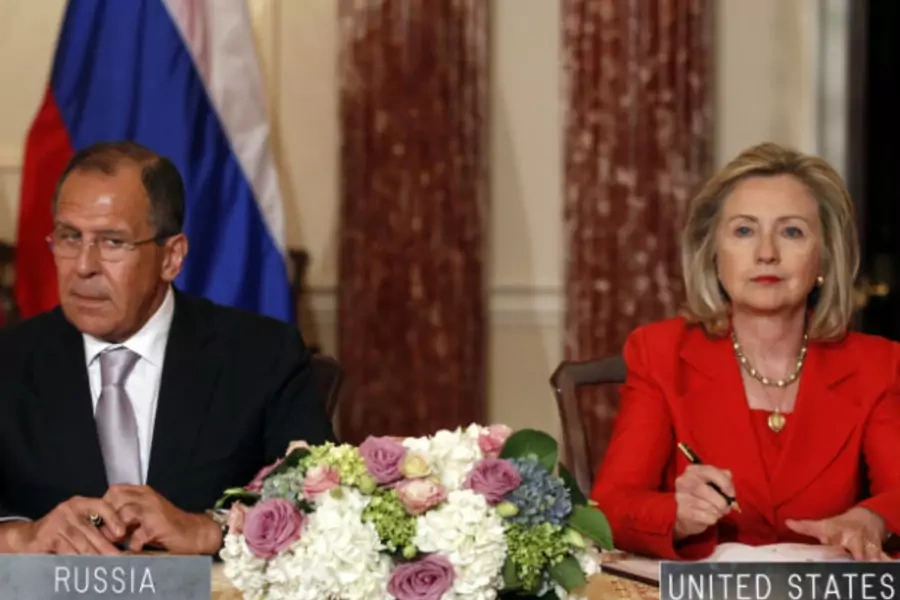Charting a Course for the United States Toward Syria

More on:
Syria continues to heat up both domestically and internationally. Anti-government demonstrations finally reached the heart of Damascus Saturday as thousands of protesters marched through the Mezze district located in the foothills beneath President Assad’s palace. It was the largest demonstration in the capital since Syrian protests erupted nearly a year ago. Violence continued elsewhere in Syria, with pro-government forces continuing their punishing bombardment of Homs. Meanwhile, Iranian warships transited the Suez Canal over the weekend—only the second time since the 1979 Iranian revolution--and joined Russian ships docked at the Syrian port of Tartus in a sign of solidarity. Russia continues to stand by Bashar al-Assad, announcing this morning that Moscow will not send a representative to the “Friends of Syria” group that will assemble in Tunisia on Friday. A hopeful word was issued by Arab League secretary general Nabil el-Araby, who told reporters yesterday that he had reason to believe that both Russia and China, which recently vetoed a UN Security Council resolution condemning Syria, may be shifting their positions.
Against this dramatic backdrop, my colleagues Elliott Abrams, Ed Husain, Micah Zenko, and I were asked by CFR.org’s deputy editor Jayshree Bajoria to address the question: What should the U.S. course of action on Syria be at this stage? Our responses, limited to 350 words each, can be read here. I post my response, Muscular Diplomacy, below:
The United States should pursue three parallel objectives in Syria: ending Assad’s rule, halting the bloodshed, and working to unify the political opposition for the day after. Time is critical--continued violence means more lives lost and a greater risk of Syria’s fragmentation. Syria’s emerging power vacuum already allows al-Qaeda bombings, armed jihadist infiltrations from Iraq, and the flow of Iranian and Hezbollah arms and possibly fighters. Civil war dramatically increases the chances of violence spilling over into neighboring Jordan, Lebanon, Iraq, Turkey, or Israel, and increases the risk that Syrian Man-Portable Air Defense Systems (MANPADS) and weapons of mass destruction will fall into rogue hands.
The United States must sustain muscular diplomacy and active high-level attention. This means fortifying the emerging coalition encompassing the Arab League, Turkey, and others in the newly-formed "Friends of Syria" contact group. This grouping provides regional legitimacy and international unity. It should tighten economic sanctions, further increase Syria’s isolation in all international fora, and help the opposition formulate a positive vision for an inclusive and representative post-Assad Syria.
Arab League leadership is key to sustaining a unified front opposing Assad’s rule. Moscow, increasingly isolated, should be encouraged by contact-group diplomacy to effectuate Assad’s transfer of power to a deputy, while initiating dialogue with the opposition coupled with an immediate and comprehensive ceasefire. This requires all to compromise, but it would safeguard Russia’s interests. Meanwhile, the UN Secretary General should be encouraged to appoint a special envoy to Syria to advance diplomatic efforts.
Finally, the United States must stop explicitly excluding military intervention. Force employed by the Friends of Syria should be the last step of an escalatory ladder. Diplomacy combined with robust sanctions must first conclusively fail. Regional troops would have to take the lead, with air and logistical support provided by NATO. To avoid this, Syria’s military should be encouraged to depose Assad immediately. Arming the Free Syrian Army and other opposition groups may eventually help topple Assad, but it also increases the potential for a fractured or failed state, given Syria’s heterogeneous composition and the disparate aspirations of the opposition groups.
More on:
 Online Store
Online Store